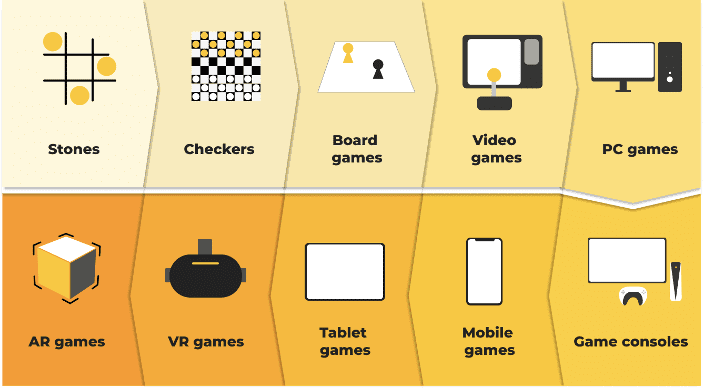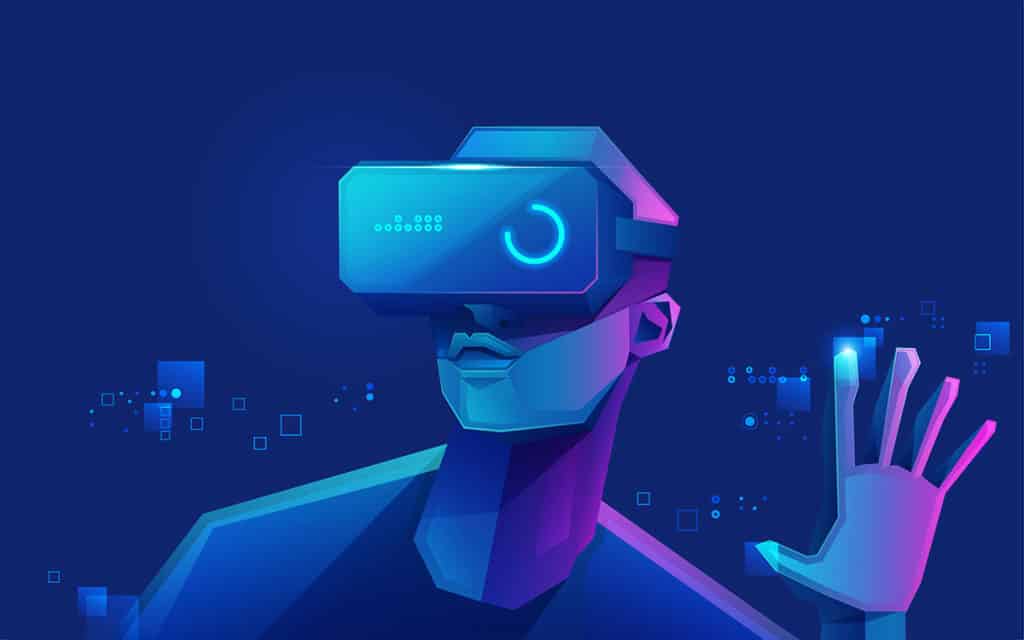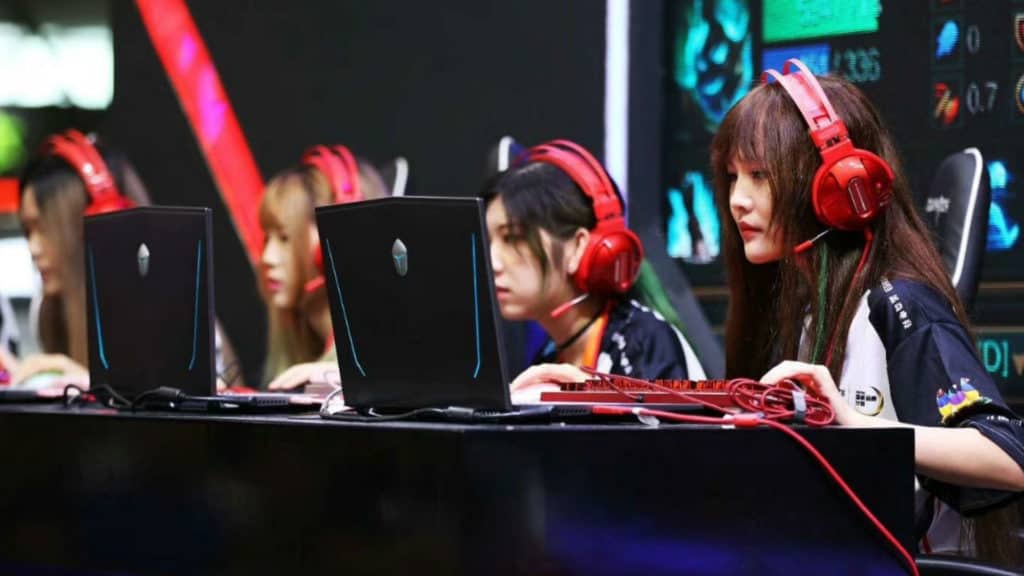The Future of Gaming: Play-to-Earn, NFTs and Virtual Reality
Gaming trends will come and go but the future of gaming looks clear. We imagine an immersive platform where billions of people will congregate to socialize, play games and engage in entertainment.
This blog looks at the evolution of gaming and explores what is influencing the future direction of this multi-billion-dollar industry.
The evolution of gaming

The gaming landscape has changed beyond all recognition over the last 20 years. In the early 2000s, the transition from dial-up connection to high-speed internet completely transformed gaming. It opened up a myriad of opportunities for multiplayer, online games and video streaming.
The next revolution in gaming was the smartphone – the first iPhone was released in 2007 – which made gaming highly accessible in players’ pockets. This led to the free-to-play business model. As most players had their credit card attached to their smartphone, gaming companies could give games away for free and make a profit through microtransactions and in-app purchases.
Read More: In-Game Spending: Tips to Keep Your Family Safe
The free-to-play business model has also led to the creation of loot boxes: virtual items in video games that contain randomized rewards. Players can either buy loot boxes and/or earn them during the game. Find out more in the Psychology of Loot Boxes blog.
Future direction of gaming
The first major gaming innovation was the internet, the second was smartphones and the third looks set to be the new internet era known as web3 which is based on cryptocurrency and blockchain technology. However, the gaming industry is constantly evolving and there are other significant developments on the horizon including the digitalization of traditional tabletop games, more sophisticated virtual and augmented reality, the metaverse and the changing demographics of gamers. This section explores the future direction of gaming.
Cryptocurrency, blockchain technology and NFTs

The next revolution is going to be crypto gaming and blockchain technology, primarily because it will capitalize on the play-to-earn business model. This is where players can monetize their time and effort while playing video games. Many money-making games offer rewards in the form of NFTs (non-fungible tokens) which are digital assets that can be bought and sold using blockchain gaming technology. Players can sell items they earn in the form of NFTs on a dedicated marketplace and translate earnings from the in-game currency into real-life rewards.
Read More: How Blockchain and Cryptocurrency Technology Could Revolutionize Gaming
The most popular play-to-earn games is Axie Infinity1. Players can buy Axies (digital creatures) and use them to battle other teams of Axies. These NFT Axies are created and sold using SLP, the in-game cryptocurrency, which can be traded for real money on the Ethereum blockchain. Players can also earn crypto by playing various games offered on the platform. Another play-to-earn virtual reality game is Decentraland2 where users are able to buy, sell and build on virtual plots of land (which are NFTs). Transactions are made using MANA, the in-game crypocurrency. Owners can choose to do whatever they like on their plot of virtual land such as create casinos, art galleries and video games. Ownership of the virtual land is guaranteed by the fact that Decentraland is built on the Ethereum blockchain. In 2021, a piece of virtual land in Decentraland sold for nearly a million dollars3.
The digitalization of traditional tabletop games
Another innovation that is gaining momentum is the transformation of tabletop games – board games, card games and parlor games – into a digital experience. The next generation of tabletop games is integrating digital tools such as livestreaming, user-generated content, podcasts and online community platforms. Livestreaming makes complex games, like Dungeons & Dragons (D&G), more accessible. By watching these streams, new players can learn the rules while being entertained. The number of D&D streamed hours has doubled every year since 2015 and in 2019 viewers watched 20 million hours of D&D on Twitch4. As tabletop games and video games increasingly converge, the next revolution is likely to be a combination of the two.
Virtual and augmented reality

With continued technological advances, virtual and augmented reality are likely to completely change the way we consume media and entertainment over the coming decade. Computer-generated environments will develop beyond all recognition to extent that it is difficult to imagine how they might reshape our lives in future. However, Forbes has made the following predictions:
- LiDAR (Light Detection and Ranging) technology will make augmented reality appear more rooted in the real world. It will provide a sense of depth to augmented reality creations and allow for occlusion – the ability to hide virtual objects behind real things.
- Virtual reality headsets will get smaller, lighter and incorporate more features such as hand detection and eye tracking technology.
- New accessories that are more affordable and mainstream will enhance the virtual reality experience. These may include robotic boots that provide the sensation of walking to match the wearer’s movements in the headset and even full-body haptic suits.
Find out more about Virtual Reality: Opportunities & Risks in our blog.
Another likely future direction of virtual and augmented reality is the metaverse – a 3D space where people can game, work and communicate. Facebook co-founder Mark Zuckerberg describes it as “an embodied internet where instead of just viewing content – you are in it.” Meta and other tech giants from all over the world are investing billions of dollars to bring the metaverse to life.
Read our blog: Into the Metaverse: How It Will Transform Our World.
The changing demographics of gamers

Gaming is no longer a social activity enjoyed primarily by young people. These days, people from all different age groups are part of the diverse gaming community. This trend looks set to continue as generations that have grown up with video games continue playing as they get older. According to Statista, the distribution of video gamers by age group in the US in 2021 was as follows:
- Under 18 years – 20%
- 18-34 years – 38%
- 35-44 years – 14%
- 45-54 years – 12%
- 55-64 years – 9%
- 65+ years – 7%.
Gaming has traditionally been dominated by male players but demographics are changing and the number of female gamers has grown in recent years. In 2019, around 45% of gamers in the US were female 5. This is a notable increase from the 38% female gaming population in 2006.
How to help clients with problematic gaming
Clinicians need to understand the future direction of gaming – and the way the lines between our physical and digital worlds are blurring – in order to reduce the associated risks, which include problematic gaming.
Our Gaming Disorder Clinical Training equips professionals with practical prevention tools, intervention strategies and mental health resources to help players enjoy a safer and healthier relationship with gaming, now and in future.
Improve your quality of care for clients and their families. Find out more about our online training today.
Footnote:
- https://axieinfinity.com/
- https://decentraland.org/
- https://www.theblockcrypto.com/post/108940/an-estate-in-virtual-world-decentraland-just-sold-for-nearly-a-million-dollars
- https://future.a16z.com/digital-future-tabletop-games/
- https://www.statista.com/statistics/232383/gender-split-of-us-computer-and-video-gamers/
Subscribe to Trends & Insights
Enter your email to receive monthly trends, insights and resources on gaming and digital disorders.
Subscribe to Trends & Insights
Enter your email to receive monthly trends, insights and resources on gaming, esports and mental health.

